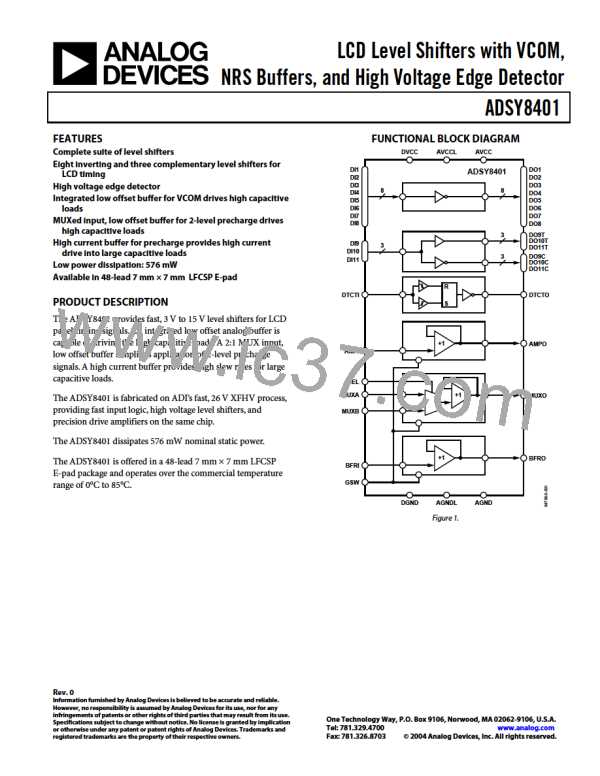ADSY8401
ABSOLUTE MAXIMUM RATINGS
Table 2.
Parameters
Supply Voltages
AVCC to AGND
AVCCL to AGNDL
AGND to AGNDL
AGND to DGND
DVCC to DGND
Stresses above those listed under Absolute Maximum Ratings
may cause permanent damage to the device. This is a stress
rating only and functional operation of the device at these or
any other conditions above those indicated in the operational
section of this specification is not implied. Exposure to absolute
maximum rating conditions for extended periods may affect
device reliability.
Rating
18 V
18 V
0.5 V
0.5 V
4.5 V
MAXIMUM POWER DISSIPATION
Input Voltages
Junction Temperature
Maximum Digital Input Voltages
Minimum Digital Input Voltages
Maximum Analog Input Voltages
Minimum Analog Input Voltages
Internal Power Dissipation1
LFCSP Package at 25°C, Ambient
Operating Temperature Range
Storage Temperature Range
Lead Temperature Range (Soldering 10 s)
DVCC + 0.5 V
DGND − 0.5 V
AVCCx + 0.5 V
AGNDx − 0.5 V
The maximum power that can be safely dissipated by the
ADSY8401 is limited by its junction temperature. The
maximum safe junction temperature for plastic encapsulated
devices as determined by the glass transition temperature of the
plastic is approximately 150°C. Exceeding this limit temporarily
might cause a shift in the parametric performance due to a
change in the stresses exerted on the die by the package.
Exceeding a junction temperature of 150°C for an extended
period can result in device failure.
3.8 W
0°C to 85°C
−65°C to +125°C
300°C
1 48-lead LFCSP package:
θJA = 26°C/W (still air): JEDEC STD, 4-layer PCB, 0 CFM airflow
θJC = 20°C/W
Exposed Paddle
The die paddle must be in good thermal contact with at least a
partial plane for proper operation in high ambient temperature
environments. The partial plane must be in good electrical
contact with AVCC or AGND for reliable electrical operation.
See the PCB Design for Optimized Thermal Performance
section for more information on the use of the exposed paddles
to dissipate excess heat.
Ψ
Ψ
JB =11.0°C/W (still air)
JT =0.4°C/W (still air)
ESD CAUTION
ESD (electrostatic discharge) sensitive device. Electrostatic charges as high as 4000 V readily accumulate on
the human body and test equipment and can discharge without detection. Although this product features
proprietary ESD protection circuitry, permanent damage may occur on devices subjected to high energy
electrostatic discharges. Therefore, proper ESD precautions are recommended to avoid performance
degradation or loss of functionality.
Rev. 0 | Page 6 of 16

 ADI [ ADI ]
ADI [ ADI ]